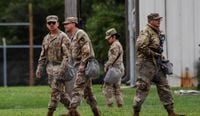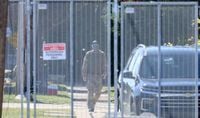It was a deployment that drew national attention—and not just because of the political storm swirling around it. On October 7, 2025, roughly 200 Texas National Guard members were sent to Illinois as part of a rapid, 60-day mission to protect federal law enforcement officials and property amid escalating anti-Immigration and Customs Enforcement (ICE) protests. The order, issued by President Donald Trump, was part of a broader federalization that included 300 Illinois National Guard members and 16 troops from California, according to Fox News and Capitol News Illinois. But almost as soon as boots hit the ground, the deployment became mired in controversy—over legal authority, political opposition, and even the fitness of the troops themselves.
The first sign of trouble came not from the courts, but from social media. A viral photo circulated widely, showing several Texas National Guard members arriving in Illinois. Many online commentators questioned the soldiers’ physical fitness, with some bluntly labeling them “overweight.” The backlash was swift and, for seven of the deployed troops, consequential. The Texas Military Department confirmed that these seven service members were recalled after failing to meet mission requirements during the pre-mission validation process. As a spokesperson explained to Fox News, “The Texas National Guard echoes Secretary [of War Pete] Hegseth’s message to the force: ‘Our standards will be high, uncompromising, and clear.’”
Indeed, Secretary of War Pete Hegseth—who had previously announced that the Department of War would require U.S. service members to meet the highest male physical fitness standards—celebrated the recall. In a tweet, Hegseth declared, “Standards are back at the @DeptofWar.” He also ordered stricter testing and daily workouts, emphasizing the administration’s push to restore what he called “military lethality.” According to Express News, Hegseth’s drive for higher standards extended beyond individual fitness: he also spearheaded the consolidation of Army North and Army South at Joint Base San Antonio, merging them into a new Western Hemisphere Command headquartered at Fort Bragg, North Carolina. This move, set to occur within weeks, was intended to streamline the force and refocus on combat readiness, though San Antonio leaders expressed disappointment at the loss of a major command center.
But while the Pentagon focused on standards and structure, the legal battle over the Illinois deployment was heating up. On October 9, U.S. District Judge April Perry issued a temporary restraining order blocking the Trump administration from deploying National Guard troops in Illinois. Perry’s decision was pointed: she found “no credible evidence that there is a danger of rebellion in the state of Illinois.” The order, set to expire on October 23, came after the state of Illinois sued to block the deployment, arguing it was an overreach of federal authority and an unnecessary militarization of their communities.
The Trump administration, undeterred, fired back. On October 17, Solicitor General John Sauer filed a 43-page petition to the U.S. Supreme Court, calling the lower court decisions “indefensible” and accusing them of “micromanaging” the president’s military authority. “A federal district court lacks not only the authority but also the competence to wrest control of the military chain of command from the Commander in Chief,” Sauer wrote, as reported by Capitol News Illinois. The administration insisted that the protests in Chicago and its suburbs were far more violent than state and local officials acknowledged, citing incidents of slashed tires on Customs and Border Patrol and ICE vehicles, as well as attacks with fireworks, bottles, rocks, and tear gas.
The legal arguments quickly became a referendum on presidential power. The 7th Circuit Court of Appeals refused to stay Judge Perry’s order, with a three-judge panel writing, “political opposition is not rebellion.” Sauer, in turn, accused the courts of “substituting the court’s own judgment for the President’s about the need for military augmentation,” and argued that the ruling “deprives” immigration agents of the protection Trump “sought to give them.” The administration’s position was clear: only the president has the right to decide when and how to deploy the military in defense of national security.
Illinois officials, however, were equally resolute. Governor JB Pritzker took to social media to declare, “Militarizing our communities against their will is not only un-American but also leads us down a dangerous path for our democracy.” He vowed that his administration would “keep defending” Illinois’ sovereignty, framing the legal fight as a defense of state rights against federal overreach.
The court’s skepticism was not limited to the violence alleged by the administration. Judge Perry, for her part, questioned the reliability of Department of Homeland Security accounts, noting that protests outside the ICE facility in Broadview, Illinois, had never exceeded 200 people. She also gave credence to allegations that federal agents were sometimes the aggressors in clashes with demonstrators. “Deploying the National Guard will only add fuel to the fire that the defendants themselves have started,” she wrote.
As the legal wrangling continued, the National Guard Bureau reiterated its policies in a statement: “All National Guard Soldiers and Airmen are required to meet service-specific height, weight and physical fitness standards at all times.” The Bureau explained that when mobilizing for active duty, members undergo a validation process to ensure compliance. “On the rare occasions when members are found not in compliance, they will not go on mission. They will be returned to their home station, and replacements who do meet standards will take their places.”
Meanwhile, the broader political context remained fraught. The Trump administration’s insistence on deploying the National Guard in Democratic-led cities—Chicago included—echoed similar showdowns in Los Angeles and Portland, Oregon. In each case, federal officials argued they were acting to protect agents and property amid what they described as insufficient support from local law enforcement. Critics, however, saw the moves as political theater and an attempt to intimidate dissent.
For the seven Texas National Guard members sent home over fitness issues, the episode was a public reminder of the military’s evolving standards—and the scrutiny that comes with high-profile deployments. For the city of San Antonio, the loss of its Army command headquarters was a blow, though local officials predicted the impact on jobs and the city’s military presence would be minimal. And for Illinois, the struggle over who controls the National Guard—state or federal authorities—remained unresolved as the Supreme Court weighed whether to intervene.
In the end, the deployment of the National Guard to Illinois became a flashpoint for debates over military readiness, presidential power, and the limits of federal intervention in state affairs. With the courts, politicians, and the public all weighing in, the only certainty was that the battle lines—legal, political, and cultural—were far from settled.

